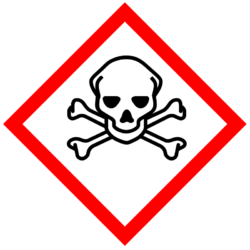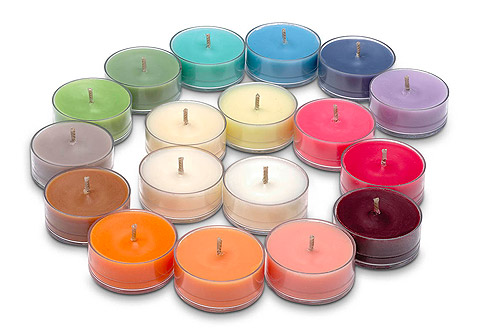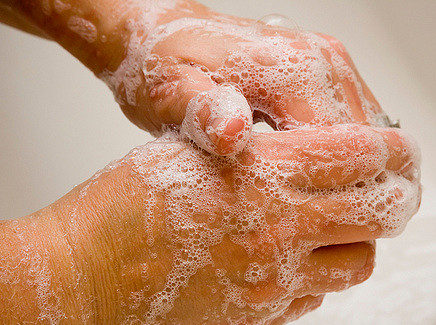Even More Reasons To Switch To An All-Natural Soap In 2020
In part 1 one this series, we discussed the dangers associated with formaldehyde and parabens which are found in many soaps sold from big corporate manufactures.
In this addition to the series we’ll be discussing two more harmful chemicals found in many soaps, Sodium Laureth Sulfates and PEG Compounds.
Remember, the more informed you are as a consumer, the better decisions you can make regarding the products you bring into your home and life.
Chemical: Sodium Laureth Sulfate (SLS)
Sodium Laureth Sulfate (SLS or SLES) is commonly used in many personal care and cleaning products as a foaming agent, detergent, and penetration enhancer.
A lot of people think a soap that produces a lot of lather means it’s doing a better job at cleaning, this couldn’t be further from the truth.
How much lather a soap produces actually has nothing to do with how well it’s cleaning your hands or body. (Source)
This is like when they talk about selling the sizzle instead of the steak! (And in both cases there are healthier options!)
Big soap companies understand that appearances matter more when it comes to buying psychology than having a high-quality product does. Especially when they are banking on a market of unconscious and uninformed consumers.
We want to help be part of the massive changes we’re seeing in our society and wake people up to the harm these chemicals are causing.
Sulfates are actually used primarily in soap products more than any other product type, so be careful when reading your labels for this one.
SLS is known as an irritant to the skin, and can cause eczema, dryness, coarse skin, and reddened skin after multiple uses. (Source)
It also can affect the eyes as an irritant and can potentially cause eye damage to young children.
While it’s not a carcinogen on it’s own, studies show it has the potential to combine with other chemicals and form a carcinogenic compound. SLS has also been linked to organ toxicity, endocrine disruption, and studies have found that residual levels of SLS stay in your organs after using products with SLS on your body or scalp.
SLS is not really worth the trouble, especially when a foaming effect can be produced naturally.
Here’s what to look out for on your product labels to avoid SLS:
Sodium laureth/lauryl sulfate (SLS) and sodium lauryl ether sulphate (SLES).
(Source)
Chemical: Polyethylene Glycol (PEG compounds)
Polyethylene Glycol, commonly known as PEG compounds or PEGs, are widely used in cosmetic products as thickeners, softeners, penetration enhancers, and moisture-carriers.
PEGs are not a single chemical but rather a group of polymers and compounds that have bonded together.
Typically they are listed in ingredients followed by a number to denote the approximate molecular weight of the compound like PEG-6, PEG-8, and so on. The lower the number the easier it is for the molecular to penetrate your skin.
(Source)
They’re not necessarily considered dangerous by themselves, but they can become contaminated in the manufacturing process with two compounds which do have links to cancers, ethylene oxide (used to manufacture mustard gas), and 1,4-dioxane.
Both ethylene oxide and 1,4 dioxane are harmful to the skin and are strong pollutants.
(Source)
Ethylene oxide (found in PEG-4, PEG-7, PEG4-dilaurate, and PEG 100) is highly toxic even in small amounts. Exposure to Ethylene oxide has been linked to increased cases of leukemia as well as other types of cancer.
(Source)
1,4-dioxane (found in PEG-6, PEG-8, PEG-32, PEG-75, PEG-150, PEG-14M, and PEG-20M) may combine with atmospheric oxygen, AKA the air, to form explosive peroxides. Not really a substance you want to rub all over your body, right?
Other contaminants that PEGs may carry are polycyclic aromatic compounds, and heavy metals such as lead, iron, cobalt, nickel, cadmium, arsenic.
Some manufactures do make attempts to remove these harmful contaminants through vacuum stripping but not all of them do so.
This is another case where you don’t need to expose yourself to risk, especially when natural alternatives like vegetable glycerin exist and work just as well.
Here’s what to look out for on your product labels to avoid PEGs:
Polyethylene Glycol, PEG-4, PEG-7, PEG4-dilaurate, and PEG 100 PEG-6, PEG-8, PEG-100, PEG-32, PEG-75, PEG-150, PEG-14M, and PEG-20M)
Try Go Peaceful Living’s All Natural USDA Organic Soaps
You won’t find either of these harmful chemical compounds in Go Peaceful Living’s soaps. All our products are certified USDA organic and make from natural plant extracts and essential oils.
There really is no need to continue to use soaps full of chemical disinfectants and preservatives now that naturally sourced alternatives are readily available.
We’re currently offering our soaps in three great scents, Mint, Citrus, and Lavender.
We’ll come back in part 3 of this series to discuss more unhealthy chemicals commonly found in so many of the products you find in your average drug store or pharmacy.
Learn What’s Really In Your Big Store Brand Soap And How It May Be Affecting Your Health
A lot of our customers have already made the decision to live a natural or organic-based lifestyle, and we think that’s great!
Others are still in the process of making changes or are just at the beginning of their personal journey, and that’s great too!
For us at here at Peaceful Living, we want to support you in living a life that feels good on every level.
One of the reasons we began this company was because we wanted to use products that were healthy for our bodies, had a low impact on the planet, and could be produced in as ethical a manner as possible.
When making any lifestyle change or trying something new there’s usually a learning curve involved.
Sometimes it looks more like unlearning and you need to set aside previous information you once believe to be the truth.
When we were developing our soaps we went through our own education process of learning about all the chemicals used in big company soaps and what affects they were having on our collective health.
We also had to unlearn some of the information packaged into marketing messages from the beauty and cosmetics industry. Especially anything that pushes consumers towards unnatural products full of lab-produced chemicals.
The choice was clear for us and we decided to produce our soaps using all natural ingredients that we can be proud of.
This article is part 1 of a multi-part series that breaks down each harmful chemical you find in big brand soaps, what health effects and issues they can cause, and why you won’t find any of them listed among the ingredients of our Peaceful Living soaps.
Chemical: Formaldehyde
Formaldehyde is a chemical that’s used in many body washes, shampoos, conditioners, and cleansers as a preservative.
It’s added as a disinfectant that works to stop the growth of bacteria, but it’s also known to be a carcinogen and has been associated with nasopharyngeal and nasal cancers, as well as neurotoxicity and developmental toxicity. (Source)
Formaldehyde has been linked to skin allergies and can weaken the immune system leaving the body prone to diseases.
Other symptoms tied to formaldehyde exposure are uneven heartbeats, fatigue, and headaches. (Source)
It’s fairly rare that you will see formaldehyde listed on a product label, maybe people are aware that it’s a harmful chemical so when it’s used it’s often combined with another chemical compound and labeled under a different name.
Here’s what to look out for on your product labels to avoid Formaldehyde:
Quaternium-15, DMDM hydantoin, imidazolidinyl urea, diazolidinyl urea, sodium hydroxymethylglycinate, 2-bromo-2-nitropropane-1,3 diol (Bronopol)
(Source)
Chemical: Parabens
Parabens are another preservative commonly used in beauty products to prevent mold, yeast, and bacteria from growing.
You will find parabens used in products just like formaldehyde, but what’s different about parabens is that they are also known as estrogen mimickers and hormone disruptors!
Exposure to parabens should be limited as much as possible, especially for women because they trick the body into thinking it’s already produced enough estrogen and it will start making estrogen in lower amounts. (Source)
This can result in decreased muscle mass, increased fat deposits, and has been linked to early onsets of puberty. Studies have also shown it can have harmful effects on the reproductive health of both men and women.
For women in particular, it’s tied to an increase in breast tumors, so it should absolutely be avoided. (Source)
Further, parabens are also tied to neurological toxicity and disorders. (Source)
Parabens come in a variety of forms, and they all come with the same risks.
Here’s what to look out for on your product labels to avoid Parabens:
Methylparaben, propylparaben, isobutylparaben, butylparaben, and ethylparaben.
Try Go Peaceful Living’s All Natural USDA Organic Soaps
You won’t find any of these harmful chemical compounds in Go Peaceful Living’s soaps. All our products are certified USDA organic and make from natural plant extracts and essential oils. There really is no need to continue to use soaps full of chemical disinfectants and preservatives now that naturally sourced alternatives are readily available.
We’re currently offering our soaps in three great scents, Mint, Citrus, and Lavender.
We’ll come back in part 2 of this series to discuss more unhealthy chemicals commonly found in so many of the products you find in your average drug store or pharmacy.
My partner and I love to burn candles. Not only do we enjoy the smell of them, but we also appreciate the ambience that they create. That’s why we were so upset when we learned that the majority of candles we had been burning up until that point, completely unbeknownst to us, were releasing a variety of potentially hazardous chemicals!
The most frustrating thing about all of this, was that none of these candles had any type of warning label pertaining to this. Not only that, but most of them didn’t even list the ingredients!
According to Anne Steinemann, an environmental pollutants expert, certain candles might emit several different unsafe chemicals, which can potentially cause damage to the brain, lung and central nervous system, and could also cause developmental difficulties. (In fact, many of the toxins released from paraffin candles are the same as those found in diesel fuel fumes.)
Steinemann goes on to say that for some people, the effects of burning certain candles are “immediate, acute and severe,” while others might not experience symptoms until many years later. (Source)
In an experiment done at South Carolina State University, several different types of candles from different manufacturers were left to burn for up to six hours in a small enclosed box. Afterwards, the substances released into the air were collected and analyzed. The experiment concluded that Paraffin-based candles, which are the most popular and widely used candles, emitted alkans, alkenes and toluene, which is a known carcinogen.
The researchers concluded that lighting paraffin candles causes several chemicals to be released into the air. They also went on to say that people who light these types of candles frequently could be at risk of developing common allergies, asthma, and in rare cases, potentially even cancer. This is most likely related to the fact that paraffin candles are by-products of oil refineries. (Source)
While this might be alarming to hear, I do honestly believe that the occasional candle enthusiast has nothing to fear. If you are only lighting a candle once or twice a month, then it is unlikely that you will experience any of these extreme symptoms. Still though, I would not recommend using paraffin-based candles at all if it can be avoided. They might be less expensive, but if you don’t use them frequently, it won’t add up too significantly. And if you DO use them frequently, then you might be putting the health of you and your loved ones at risk.
Sources: 1. http://www.huffingtonpost.com/2015/06/16/scented-candles-toxic-safer-options_n_7536410.html
After years of using bar soap and deodorant without even ONCE looking at the ingredients, my partner came across some disturbing information. She informed me that there were a large amount of harmful chemicals present in the bar soaps and deodorants that we were using at the time. My response, of course, was “so what?”. I figured as long as I wasn’t eating them, (by the way, Peaceful Living™ deodorants are so organic that they are actually safe to eat), it didn’t matter what chemicals were in them!
That assumption was what kept me from ever looking into what ingredients were in my personal care products.
In the last few years, my partner and I have been doing research to try and find the truth with regards to this subject matter. While we have not found anything 100 percent conclusive, we have found enough evidence to make the personal decision to stop using chemical filled products. From a logical perspective, we find no point in taking a risk with our health while the jury is still out!
Below you will find some excerpts of what we have found, that are intended to help make your research easier to conduct (we encourage you to do your own research!)
According to Jane Houlihan, the director of cosmetics safety research for the EWG, or Environmental Working Group, (which is a nonprofit research and advocacy organization), research has shown that many conventional personal-care-products contain chemicals of concern that can disrupt your hormones, cause allergies, or can damage your skin. (Source)
Many people tend to ignore the fact that much of what is applied to your skin, is often absorbed into your blood stream. Think about it ; if it were not possible, than how would things like nicotine patches or birth control patches be effective? Both of these products make use of the absorptive quality that the skin possesses, and successfully accomplish tasks such as weening people off of cigarettes and preventing pregnancy!
Furthermore, according to WebMD, Premarket safety testing is not something that is usually done for personal care products.
In a 2008 study, high levels of phthalates were found in the urine of babies that were recently soaped or slathered with baby shampoo, powder, or lotion. Although that study was back in 2008, still to this day, manufacturers aren’t required to list the specific chemicals that make up fragrances, and fragrances often contain phthalates, which are used to make smells last longer. For this reason, WebMD recommends looking for products that say “No Phthalates” or “Phthalate Free”. (Source)
One study published on Pubmed, a very reputable free search engine which accesses primarily the MEDLINE database of references and abstracts on life sciences and biomedical topics, states that some chlorinated compounds such as Pthalates and Parabens, are fat soluble and can be absorbed through our skin. It goes on to mention that Pthalates have been associated with several serious health problems, including infertility, testicular dysgenesis, obesity, asthma, and allergies. The study, however, does not specify if these health issues are from the use of personal care products, and the FDA has not found evidence that the amount of Phthalates present in products on the market is unsafe. Still, just because there is not enough evidence yet, does not mean that we should continue to use these products until there is. (Source)
As a matter of fact, the notion that they have not found evidence proving they are unhealthy is not too comforting for me, considering that (according to a Harvard.edu publication), there is minimal, if any, safety testing on most of these products. And even to this day, the FDA has little power to regulate the ingredients in personal care products, under a law that has not been updated since 1938! This law provides companies with “loopholes” such as being able to label their products as organic, natural, or hospital-approved based solely on their own interpretation of the terms. The only way that you can be absolutely sure of what is in a product, is if it is Certified Organic by the USDA. Otherwise, companies are free to “hide problematic ingredients in proprietary formulations by listing them as “fragrance” on the label.” (Source)
Other than Pthalates and Parabens, here is a list of chemicals commonly found in shampoos, deodorants, moisturizers, soaps, or makeup that should be given some attention : Formaldehyde, Diethanolamine, Triclosan, Propylene Glycol, Sodium Lauryl Sulfate, Synthetic Coloring, Synthetic Fragrance, Aluminum, and Lead. A great article published by the Huffington Post which goes into greater detail about the potential negative effects of these chemicals can be read here : (Source)
We hope that you will look further into the information presented on our website. Regardless what conclusion you draw, there is one thing that is an absolute fact; Your skin is your largest organ, and you should be careful with what you put on it (especially on a daily basis).
Sources : 1. https://www.washingtonpost.com/national/health-science/soaps-makeup-and-other-items-contain-deadly-ingredients-say-consumer-advocates/2012/01/24/gIQAeJ56cQ_story.html 2. http://www.webmd.com/children/environmental-exposure-head2toe/personal-care-products?page=1 3. http://www.ncbi.nlm.nih.gov/pubmed/21155623 4. https://www.hsph.harvard.edu/news/features/harmful-chemicals-in-personal-care-products/
5. http://www.huffingtonpost.com/vanessa-cunningham/dangerous-beauty-products_b_4168587.html



